Financial Stability Review – April 2019 3. The Australian Financial System
The Australian financial system remains resilient and its ability to withstand shocks continues to strengthen. Banks' capital ratios are much higher than they were a decade ago and high compared with international peers. They are also now sufficient to withstand a shock of equivalent magnitude to the majority of historical bank crises. Capital ratios have been supported by high profit levels, although profits have not grown much in recent years as banks divested non-interest income-generating businesses. However, divestments of these capital-intensive subsidiaries support capital ratios. Asset quality remains strong – supported by stronger lending standards over recent years – though the share of non-performing housing loans is edging higher, particularly in mining-exposed areas. Banks' management of their funding and liquidity needs has settled in a new dynamic following an extended transition to more stable forms of funding and increased holding of liquid assets. A key focus in recent years has been increasing defences against rising threats from cyber attacks.
Addressing deficiencies around culture and governance revealed by the Royal Commission into Misconduct in the Banking, Superannuation and Financial Services Industry poses a challenge for the financial system. While positive steps have already been taken by institutions and regulators, more needs to be done to ensure services meet public expectations and risks of future misconduct are reduced. Managing the large number of changes stemming from the Royal Commission is a substantial task for some financial institutions. Because of the scale of this task, there is a risk that implementation is delayed or piecemeal, issues around misconduct are not adequately addressed, or that it distracts banks from appropriately managing other risks. The costs of implementing these changes and reimbursing mistreated customers will impact the profits of financial institutions, though this impact appears manageable and, in effect, corrects for past profits being inflated by poor practices. The life insurance industry faces substantial challenges. Regulatory reform to address issues revealed by the Royal Commission and other inquiries, as well as structural issues around underpricing and loose product definitions, could have a sizeable impact on profitability.
A tightening in the lending standards of authorised deposit-taking institutions (ADIs) over recent years has contributed to an increase in lending for property by non-ADIs. While non-ADIs are not subject to prudential regulation, the risks they pose to financial stability remain limited as they account for a small share of overall housing loans. Systemic risks in other parts of the financial sector remain generally low. General insurers' profitability remains steady and they continue to use reinsurance to manage higher natural disaster claims. The superannuation industry will likely face some challenges following the Royal Commission and the Productivity Commission's review of superannuation. Low debt within prudentially regulated funds means that risks to members' funds are minimal.
Culture and governance within financial institutions need improving …
Deficiencies of culture and governance within financial institutions have been highlighted over the past year, as the Royal Commission disclosed numerous instances of misconduct.[1] The most egregious examples examined by the Royal Commission included charging financial advice fees without providing a service, not acting in the best interests of superannuation fund members and unscrupulous selling of insurance and handling of insurance claims. The commissioner attributed these failures to four underlying causes: incentives that rewarded sales and near-term profit but did not always encourage compliance with the law and proper standards; an imbalance of power and knowledge between providers of financial products and services and their customers; conflicts of duty and interest between intermediaries (like mortgage brokers and financial planners) and their customers; and, too often, financial services entities that broke the law were not properly held to account by regulators.
The findings from the Royal Commission supported the conclusions of the Australian Prudential Regulation Authority's (APRA's) earlier Prudential Inquiry into the Commonwealth Bank of Australia (CBA). That inquiry highlighted that CBA's continued financial success had allowed it to develop a culture of complacency towards managing operational, compliance and conduct risks. This included paying insufficient account to poor operational risk and customer outcomes, despite effectively managing financial risks.
The absence of a good culture in the financial sector has clear social costs. It can also have financial stability implications. International experience has shown that pervasive misconduct may be indicative of poor control of risks and can significantly impair bank profitability and capital.
Positive steps are being taken, but change can be challenging
Financial institutions and regulators have already taken important steps to improve culture and governance in the financial system. Financial advisors are, in some cases, removing grandfathered conflicted remuneration arrangements and increasing standards of education in response to the government's reforms to raise professionalism in the industry. Some conflicts of interest faced by mortgage brokers have been reduced by ending volume-based commissions and paying upfront commissions on funds drawn, rather than total loan amounts. Banks have been revising variable pay structures to improve incentives to manage non-financial risks. Banks have also developed maps of accountable senior executives and directors in response to the introduction of the Bank Executive Accountability Regime (BEAR). Regulators have also been more active in enforcing the law.
The recommendations made in the Final Report of the Royal Commission will require further changes to legislative frameworks and to how regulators and financial institutions operate. These recommendations include: addressing conflicts of interests in mortgage broking and financial advice; simplifying laws by removing numerous exceptions to ensure that the intended behaviour is clear to all; placing the onus on financial institutions to strengthen culture and governance practices, including by designing and regularly reviewing remuneration arrangements to ensure they provide the right incentives; and strengthening how regulators respond to misconduct and are held accountable for their performance.
Changes are clearly needed to improve the financial system. Changes should reduce the risk of future misconduct, ensure the quality of financial services provided in Australia meets community expectations, and protect the reputation of Australian banks among international creditors. However, there are risks associated with the design and implementation of reforms. One risk is that the implemented reforms do not fully address the issues identified by the Royal Commission, are not timely or distract banks from managing other risks. Another is if the reforms excessively tighten the supply of credit (see ‘Chapter 2: Household and Business Finances’), which, by its nature, requires taking risks.
Responding to the Royal Commission's recommendations will also increase financial institutions' costs, but will increase system resilience in the long term. In a sense, this corrects past underspending on systems or unfair revenue collection. In the near future, firms will incur further remediation costs relating to the charging of ‘fees for no service’ in the wealth management industry; these already exceed $1 billion. Revenue in the life insurance industry could also be significantly impacted (see below). Costs will also rise as firms correct for underspending on information technology (IT) systems in the past, compliance requirements increase and legal fees rise as regulators take more legal enforcement. There could also be payments resulting from lawsuits. The Australian financial system is well placed to manage these challenges, given it is well capitalised and generally starting from a position of strong profits.
Banks' resilience is underpinned by strong overall asset performance …
Australian banks' domestic asset performance remains strong and broadly in line with that seen over the past few years. This is despite a slight deterioration over 2018 that was predominantly due to the performance of housing loans (Graph 3.1). The recent small decline in housing loan performance has occurred alongside very low levels of business loan non-performance. More generally, loan impairments have remained at historically low levels largely because of the strong collateral position underlying housing loans despite large price declines in some locations. However, there is a risk that some housing loans that are already past due will become impaired if the value of the dwelling securing the loan were to fall substantially further.[2]
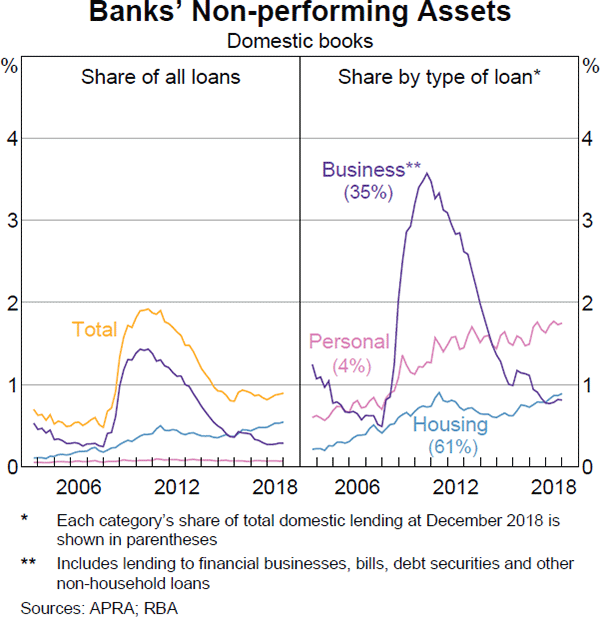
Another risk to banks' asset performance is the potential for rapidly rising lending by foreign banks to amplify the credit cycle, particularly for business credit. Foreign-owned banks operating in Australia have accounted for more than half the total growth in business credit over the past two years, despite accounting for less than 20 per cent of existing loans. Much of the growth in business lending has been by Asian banks, but lending by European banks is now also growing strongly. Recent growth in foreign bank lending has primarily reflected their involvement in funding large infrastructure projects. Historically, rapid expansion by foreign banks has amplified the credit supply cycle and prompted domestic banks to loosen lending criteria to retain market share. In the current upswing, however, these risks have so far been contained by both increased regulatory scrutiny and a cautious approach by banks.
… while their assets have become more concentrated but simpler
Banks' business models are becoming simpler, but less diversified, as they shed their wealth management and life insurance businesses. The profitability of these businesses had historically been uncorrelated with core banking income and more stable during downturns. Banks have also reduced their level of diversification by retreating from international lending (Graph 3.2). Over recent years, Australian-owned banks have sold foreign subsidiaries and scaled back their overseas lending across a range of countries, with the notable exception being New Zealand. Abstracting from New Zealand and their holdings of sovereign bonds or foreign central bank deposits (to satisfy regulatory requirements), the international exposures of Australian-owned banks now only accounts for 8 per cent of banks' assets.
The pull-back from wealth management and international lending has allowed banks to focus on domestic lending, particularly for housing, which has historically been more profitable. It also reduced operational risks by minimising the complexity associated with operating in multiple jurisdictions. However, the greater concentration of home lending in Australia and New Zealand, whose economies have historically been highly correlated, has also reduced diversification. High levels of concentration in particular asset classes can create vulnerabilities for financial institutions.
Even though Australian banks are now more domestically focused, the performance of their remaining international assets is still sensitive to global shocks, such as a disruptive Brexit. The risk of impairments on loans to the UK non-bank private sector are small given Australian banks' low exposures (only 1–2 per cent of total assets). However, a disruptive Brexit could pose more risk to global funding and hedging markets used by Australian banks.
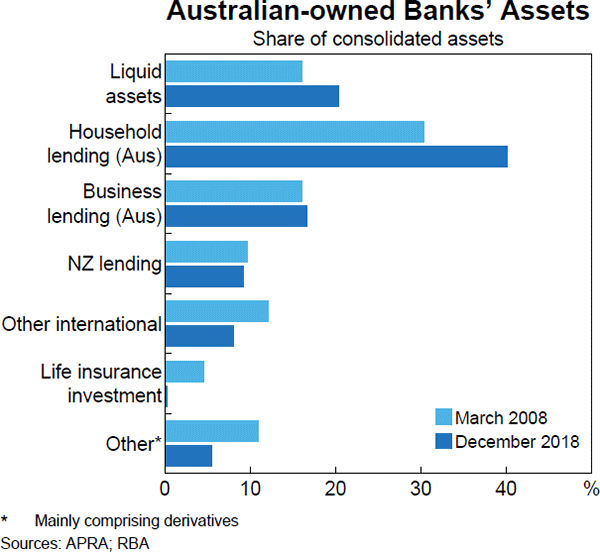
Cyber attacks or failures of information technologies could cause material losses
Risks related to IT have increased over time. IT systems have become more complex and digital platforms have become more widely used by banks and their customers. Some financial institutions also have legacy systems that are more vulnerable to failure and the resources to restore them may not be readily available. Against this background, the threats from cyber attacks that result in theft, disruption or damage have increased. This is a constantly evolving threat that requires firms to regularly upgrade their defences to mitigate new vulnerabilities. While cyber attacks and malfunctions are most likely to involve manageable financial losses for specific institutions, they could have systemic implications in some circumstances. An example of this is an attack or malfunction that erodes data integrity, thereby creating uncertainty about banks' asset or liability positions. An extended disruption to the Australian wholesale payment network would also be challenging, as discussed below. The impact of cyber attacks or a significant malfunction could also be amplified by a loss of creditor confidence, potentially leading to a withdrawal of funding.
Banks and regulators are working to increase the security and resilience of the Australian banking system's IT assets. APRA recently introduced prudential standards for information security. These will shore up Australian banks' resilience against information security incidents (including cyber attacks) and their ability to respond effectively in the event of a breach.
Liquidity risks are being well managed …
One measure of how banks are managing liquidity risk is their Liquidity Coverage Ratio (LCR), which measures their buffer of liquid assets against short periods of liquidity stress. The system-wide LCR has remained stable at around 125–135 per cent over recent years, above the 100 per cent minimum requirement. Another measure of liquidity risk management is the Net Stable Funding Ratio (NSFR), which captures the extent to which more stable liabilities are used to fund less liquid assets. NSFRs have risen to be around banks' target levels and above regulatory requirements.
One vulnerability banks face is their use of offshore funding. Offshore investors are more prone to repatriate their investments during periods of financial stress, as investor home bias increases. Because of this, the International Monetary Fund (IMF) raised concerns about the extent to which Australian banks source wholesale funding from offshore markets during its Financial Sector Assessment Program (FSAP) of Australia last year (see ‘Box E: The 2018 Financial Sector Assessment Program (FSAP) Review of Australia’). A few factors reduce the risks to Australian banks that arise from offshore funding. Australian banks fully hedge the foreign currency (and interest rate) risk arising from their use of foreign-currency debt. In addition, Australian banks use most of their offshore funding to finance Australian assets, rather than foreign currency-denominated assets. This means that Australian banks could substitute domestic funding for foreign funding in response to a disruption in global markets. Their ability to do this may well be constrained by the capacity of domestic markets, although ultimately the Reserve Bank can provide liquidity as required. In a period of financial stress, the Australian dollar may well depreciate, as it has in the past. This would reduce the quantity of foreign funding that banks would need to roll over and support their liquidity as derivative counterparties would need to post additional margin.
Accessing offshore markets has allowed Australian banks to issue debt at longer tenors than they can issue domestically. Longer tenors have been important in reducing banks' future refinancing risks and vulnerability to market disruption. Since late 2014, banks have increased the residual maturity of their offshore wholesale funding from 3½ to 4½ years (Graph 3.3). This extension of maturity has had only a little impact on the cost of funding due to very low term premia in bond yields during this time.
Spreads on Australian banks' long-term wholesale funding have increased since the start of 2018 (Graph 3.4). This rise in spreads on Australian bank bonds has been consistent with a move higher in spreads on international banks' and non-financial corporation bonds, implying that the move reflects greater risk aversion rather than a reassessment of the riskiness of Australian banks. Bank bond spreads and, in particular, credit default swap (CDS) premia, still remain low by historical standards and banks continue to be able to issue comfortably in long-term funding markets.
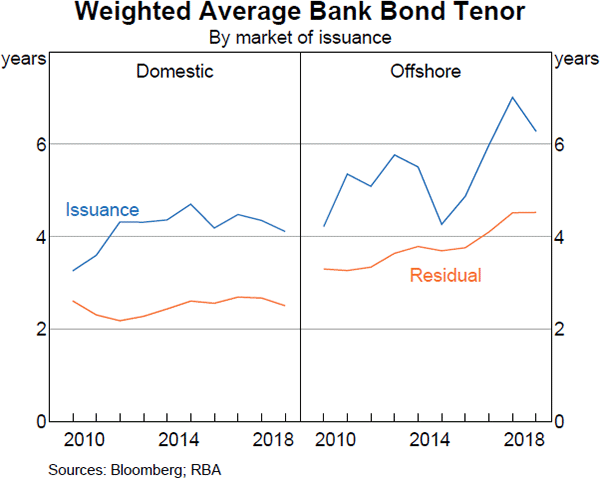
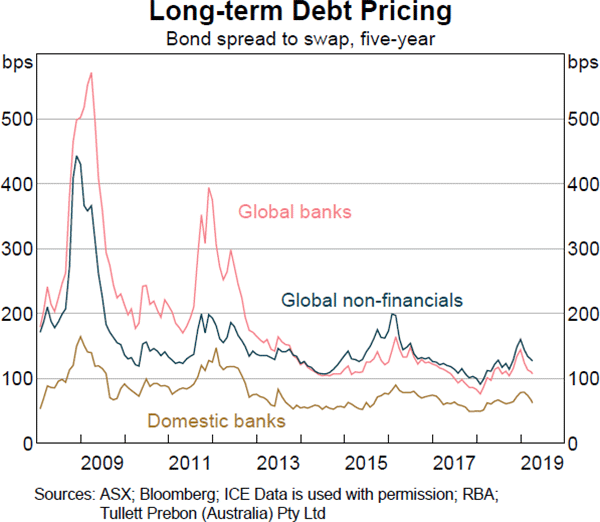
Over the past year, spreads on short-term debt issued by Australian banks have been around their highest levels since the global financial crisis (Graph 3.5). Spreads also increased in US money markets. These increases have been especially pronounced near the end of each quarter. In the past, wider spreads have typically been an indicator of higher perceived near-term credit risk of banks. However, as discussed above, other measures of banks' long-term credit risk, such as bond spreads and CDS premiums, remain low, indicating that credit risk is not driving the increase in spreads.
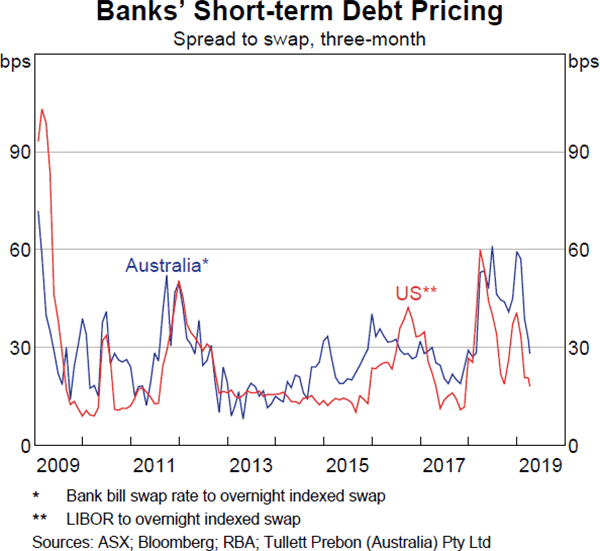
While there is some uncertainty around the underlying cause of the rise in the level and volatility of short-term funding spreads, it appears to be largely related to structural developments in money markets. As discussed in recent Statements of Monetary Policy, changes in asset allocations by investment funds and increased demand for Australian-dollar funding by banks operating in Australia have contributed to lifting the average level of the bank bill swap rate (BBSW). Another factor that has increased volatility is reduced depth in some short-term money markets, particularly around end-of-quarter periods. Reduced depth is, in part, a consequence of banks being less willing to supply liquidity due to changes in banking regulation – including the Dodd-Frank Act, introduction of leverage ratios and a change in banks' risk appetite and greater focus on conduct in money markets. A persistent rise in the average level of BBSW imposes additional costs on banks that may be passed on to retail interest rates, but this alone does not imply financial stability risks. In contrast, the recent volatility of BBSW indicates that money markets have less capacity to accommodate changes in supply and demand and so are more prone to tightening than in the past.
… and banks' capital positions are strong
Australian ADIs mostly already meet APRA's higher ‘unquestionably strong’ capital benchmarks that will apply from next year. Major banks' Common Equity Tier 1 (CET1) ratios are all at, or close to, APRA's benchmark of 10½ per cent (Graph 3.6). The completion of already announced divestments of wealth management and life insurance businesses over the coming years are expected to further boost these ratios as not all of the capital released is expected to be returned to shareholders. Other ADIs also have sufficient capital to meet the expected increase in their minimum capital requirements.
The increase in capital has made ADIs more resilient to solvency shocks. Major banks' Tier 1 capital ratios are now more than one and a half times what they were before the financial crisis, and are within the top quartile of large banks internationally when measured on a comparable basis (Graph 3.7). Major banks' Tier 1 capital ratios (12¾ per cent) are also well within the range that would have been sufficient to withstand the majority of historical bank crises.[3] The major banks' leverage ratios (the ratio of Tier 1 capital to non-risk-weighted exposures) have also increased, rising by more than one-third over the past decade to be well above APRA's proposed minimum requirements of 3.5 per cent.
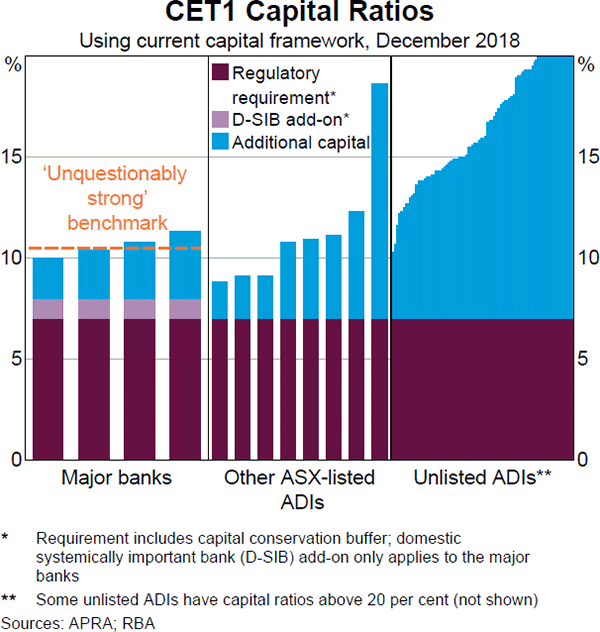
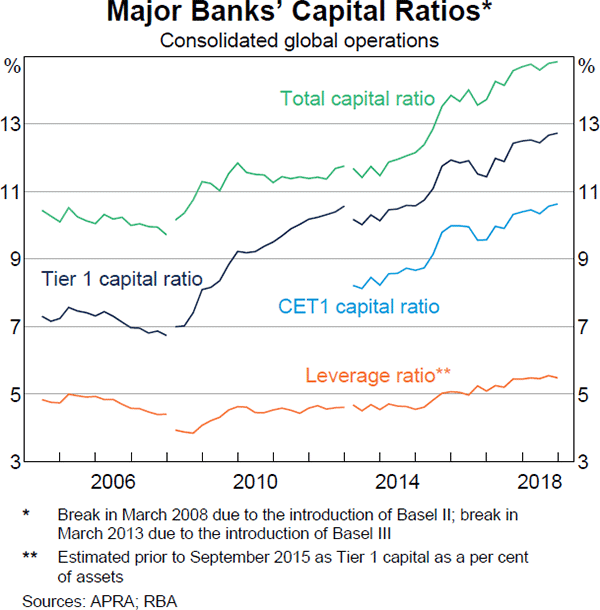
The capital available to protect the financial system and the economy from a disorderly bank failure will increase further with APRA's recently proposed framework for loss-absorbing capacity to support orderly resolution. The proposed framework would apply to the major banks (and possibly some other ADIs with complex business models) and will increase the total capital requirements of these ADIs by 4–5 percentage points from 2023. This would align major banks' loss-absorbing capacity with global peers, accounting for differences in capital frameworks. Banks are expected to meet this additional capital by issuing Tier 2 capital instruments. APRA is consulting with industry on the proposal and is expected to finalise the framework later this year.
In December, the Reserve Bank of New Zealand proposed to increase minimum CET1 capital ratios for systematically important banks to 16 per cent, while also raising average risk weights (see ‘Chapter 1: The Global Financial Environment’). Australian banks may have to increase their group capital ratios to meet both these higher requirements for their New Zealand subsidiaries and APRA's requirements for their Australian operations. The increase in required capital for a New Zealand subsidiary could come from retaining most of their profits in New Zealand (which would directly increase group capital) or via an equity injection from the parent bank (which would require the parent bank to increase its own capital as equity in a subsidiary is counted as a risk-weighted asset). Australian banks could be constrained from increasing their equity exposures to their New Zealand subsidiaries due to maximum exposure limits imposed by APRA, though these standards are currently being reviewed.
Bank profits remain healthy, but are under pressure
Banks' resilience and capital generation has been underpinned by high profits over many years. However, profits have remained broadly steady since 2014 (Graph 3.8). The absence of growth mainly reflects a fall in non-interest income as banks have sold or scaled back a number of their fee-generating activities, while the contribution from falling bad and doubtful debt charges is less than in the past. More recently, a narrower net interest margin (NIM) due to pricing competition and higher funding costs has reduced interest income growth. In addition, operating expenses have increased due to higher compliance, IT and customer remediation costs. As profits and capital have both steadied, so too has banks' return on equity (ROE). ROE is now a few percentage points lower than its historical average but remains high compared with international peers.
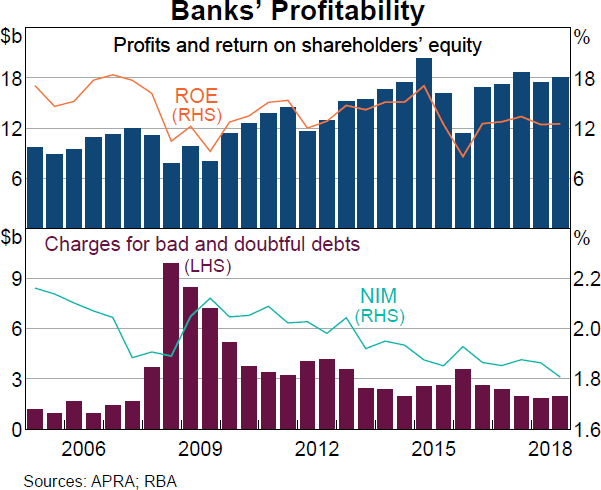
Analysts expect minimal growth in bank profits over the year ahead. Net interest income growth is expected to be below average as credit growth slows further and NIMs remain under pressure. Bad and doubtful debt charges are also expected to pick up a little from their current very low level. The final cost of remediation for misconduct identified over recent years is uncertain, and could exceed existing provisions, while spending on compliance and IT may remain elevated in order to address some of the recommendations of the Royal Commission. Overall, there appears to be greater-than-usual uncertainty about the future profit outlook for banks because of the increased scrutiny on banks and the weaker outlook for property prices and housing credit growth.
Heightened uncertainty about future profitability has raised Australian banks' implied cost of capital, as measured by the forward earnings yield on their stocks (Graph 3.9). Earnings yields have moved higher for bank stocks globally, suggesting that a reduction in global risk appetite for banking stocks has also been a factor. The rise in banks' forward earnings yields has been about a half percentage point more over the past year than forward earnings yields for other Australian stocks. This widening gap continues a pattern of the past four years. Banks' current forward earnings yields are now above their pre-crisis average, despite a large decline in risk-free rates.
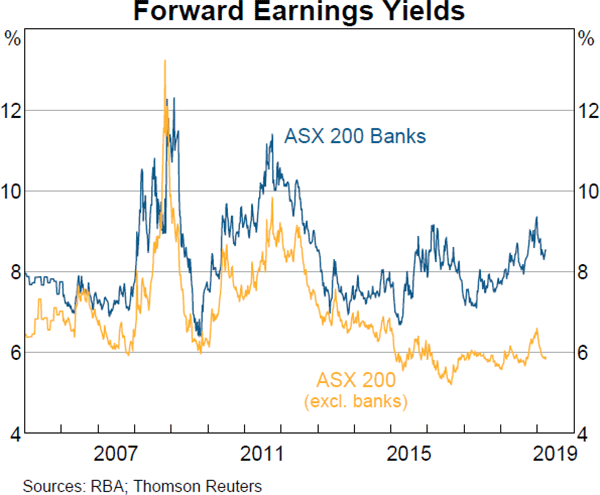
Non-ADI lending is growing in some areas, but still accounts for a small share of overall lending
Tighter prudential regulation of ADIs over recent years has contributed to some lending activity migrating to less regulated non-ADI lenders. Property lending is one area which warrants particular attention given the significant tightening of lending standards between 2014 and 2017. While non-ADI lenders have increased their share of property lending over this period, financial stability risks from this shift remain limited for now (see ‘Box D: Non-bank Lending for Property’). Outside of property, there is little evidence of strongly increasing lending from non-ADIs. Overall debt financing from the non-ADI sector has remained steady at around 7 per cent of the financial system, well below the share in 2007 (Graph 3.10). The risk of contagion from non-ADI lenders to banks is also limited given the low level of banks' exposures to the sector (only a few per cent of their financial assets). Data on non-ADI lending activity are currently limited, which makes it difficult to properly assess these risks. Legislation passed in March 2018 that provides APRA with greater data collection powers should help improve coverage of non-ADI lenders. It also provides APRA with ‘reserve’ powers to impose rules on non-ADI lenders if their activities are judged to pose a material risk to financial stability.
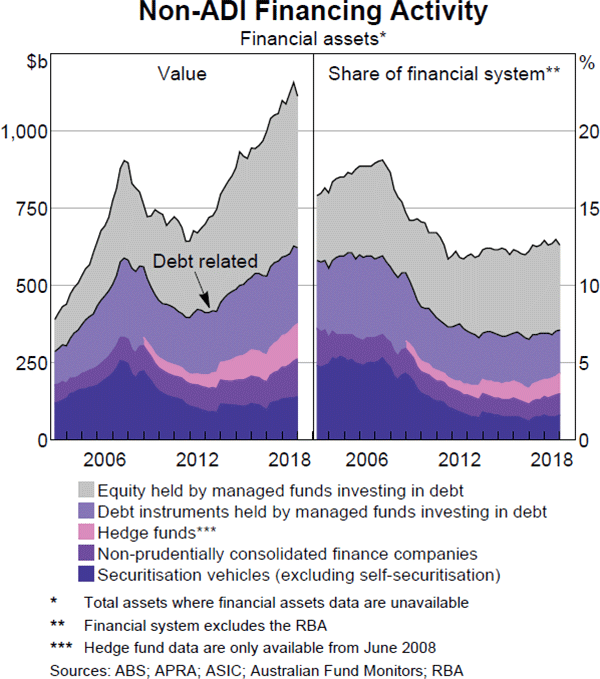
The general insurance industry is in good health …
General insurers' profits remained at a healthy level in 2018 after improving over the previous few years (Graph 3.11). The improvement in profits was due to stronger underwriting results that partly offset a decline in investment returns. General insurers continued to benefit from increases in insurance premiums in some consumer and commercial business lines, a reversal from earlier downward pressure on underwriting margins. The growth in premiums and lower-than-expected inflation allowed insurers to release more reserves than usual, which has helped steady insurers' claims ratios (net incurred claims relative to net premiums) over recent years. Natural disaster costs increased in the second half of 2018, but reinsurance arrangements have reduced the impact on direct insurers' profits. Insurers also remain well capitalised, with capital equivalent to 1.7 times APRA's prescribed amount.
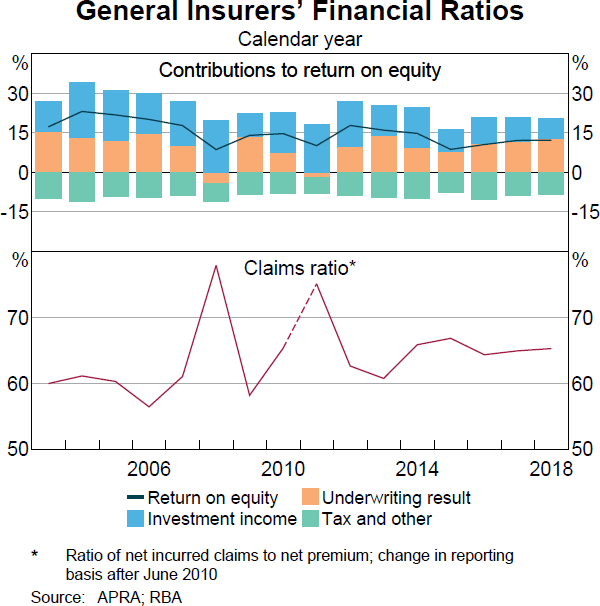
Lenders mortgage insurers (LMI) are also well capitalised, but their profits remain under pressure. Revenues have declined due to the low volume of new high LVR mortgage lending, which is generally insured (see ‘Chapter 2: Household and Business Finances’). Claims have also increased due to the small rise in impairments, particularly in Western Australia. As discussed in the October 2018 Financial Stability Review, the Productivity Commission's recommendations to improve choice for LMI customers, if adopted, could add additional pressure to profits.
… but there are sizeable challenges in life insurance
Life insurers' profits continue to decline and the industry reported a loss in the second half of 2018, driven by weak investment returns and a write-off of goodwill (Graph 3.12). Forthcoming changes in the industry will add further pressure on profitability. These changes include regulatory reform to address the issues raised at the Royal Commission and the Parliamentary Inquiry into the life insurance industry. A recommended ban on unsolicited selling of life insurance and the review of life insurance commissions will impact insurers' revenues. Legislation to require insurance within superannuation funds to be offered on an opt-in basis for inactive accounts will also affect revenues from group life insurance policies unless premiums are increased for other members. These recommendations compound persistent structural issues affecting profitability, including historical under-pricing of policies, loose product definitions, overly generous benefits and rising claims, particularly for mental health. The latter has particularly weighed on individual disability income insurance, which accounts for much of the recent decline in profit. This has been an area of heightened focus for APRA and is the subject of a thematic review. These issues will take a long time to resolve given the long-term nature of insurance contracts and the pressure to retain market share in a competitive market.
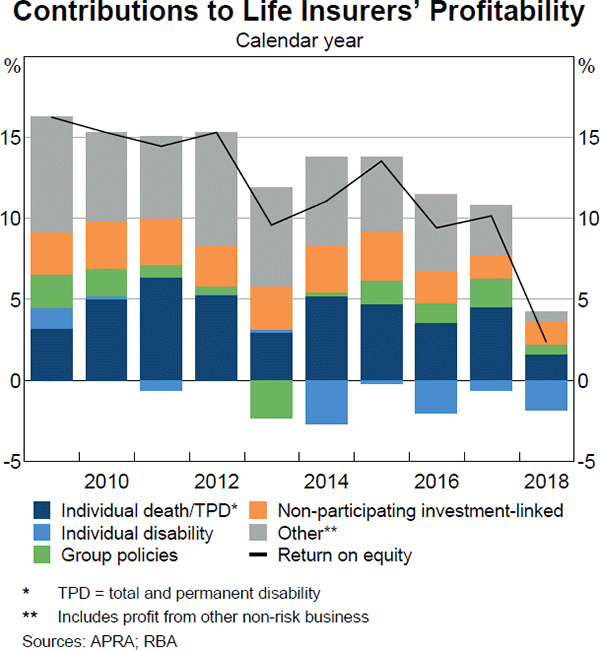
The change in ownership of life insurers over recent years may help them to manage this transition. Almost all Australian banks have sold, or announced the sale of, their life insurance businesses to large global insurance specialists. These new owners have underwriting expertise, scale and strong financial resources which should have them well placed to undertake the necessary change. The sector remains well capitalised, with capital equivalent to 1.8 times the prescribed amount.
The superannuation sector also faces challenges, but these don't risk member funds
Significant changes to the superannuation sector are likely following the Royal Commission, the Productivity Commission's superannuation review and the sale by most major banks of their wealth management businesses.[4] In particular, proposals to ‘staple’ a single default account to each worker or to introduce a shortlist of top superannuation funds would reduce inflows for some funds. A focus on addressing underperforming funds could lead to closures. While this transition will involve challenges and give rise to operational risk, the lack of debt within APRA-regulated funds – which are not generally permitted to borrow – makes these risks more manageable without risk to members' funds.
In contrast, self-managed superannuation funds (SMSFs) are permitted to borrow under certain arrangements. The use of such debt has increased in recent years, mainly to purchase property. The use of debt within SMSFs raises policy concerns and has been associated with inappropriate or conflicted financial advice, creating a risk to some individuals' retirement savings.[5] However, leverage in SMSFs as a whole is just a few per cent of assets and poses little risk to broader financial stability at this stage. The take-up of SMSF borrowing arrangements has slowed recently and most banks have ceased lending to the sector in light of the financial and reputational risks associated with it.
Further strengthening of financial market infrastructures remains a priority
Financial market infrastructures (FMIs), such as central counterparties (CCPs), securities settlement systems and payment systems can strengthen the markets they serve and play a critical role in fostering financial stability. CCPs have the potential to significantly reduce risks to participants through the multilateral netting of trades and by imposing more-effective risk controls on all participants. However, if a CCP's risk controls fail to work as designed, a CCP can transmit risk to its participants.
The potential risks were demonstrated in September 2018, when an individual who participated directly in Nasdaq Clearing AB (a Swedish CCP that is a subsidiary of the Nasdaq Group) defaulted. The individual defaulted because he could not meet a margin call to cover losses on a concentrated position on the spread between German and Nordic power futures prices. To cover the defaulter's position, Nasdaq Clearing AB used all of the defaulter's collateral that it held plus €7 million of its own capital and €107 million of default fund contributions from other participants. The call on the default fund drained about half its resources.[6] While CCPs are designed to mutualise large losses in this way, it was not expected that the default of a private individual would cause mutualised losses on this scale.
Following the default, Nasdaq Clearing AB has announced plans to enhance its risk management framework.[7] In broad terms, these plans include: increasing initial margin requirements; improving the auction process used to manage defaults; enhancing participant eligibility requirements; and increasing the amount of its own capital at risk in a default.
Australian regulators have also reviewed the risk management of Australian-licensed CCPs following the Nasdaq incident. These reviews have covered both arrangements for electricity derivatives (which both ASX Clear (Futures) and CME are licensed to clear) and those for derivative trading more broadly. This has assured regulators that, to the extent that the issues faced by Nasdaq are relevant, Australian-licensed CCPs had already identified these issues and have plans to address them.
- Initial margin framework: The frameworks used by the Australian-licensed CCPs already incorporate most of the enhancements Nasdaq Clearing AB is planning to implement. For electricity derivatives, ASX increased the margin it collects in January 2018, based on analysis that it would take longer than previously anticipated to liquidate these contracts. Following the default at Nasdaq Clearing AB, ASX made one further adjustment to electricity derivative margins. This was to reduce the number of margin offsets it offers, effectively increasing margin requirements (since margin offsets reduce margin, typically based on the historical correlation between products whose value is linked through an economic or financial relationship). Margin requirements for Australian electricity derivatives were also considered as part of CME's application for a licence variation to clear for the market operated by FEX Global Pty Ltd, which was granted on 26 February 2019.
- Default management framework: CCPs operating in Australia run regular default management drills for all of their products. The RBA will be engaging with ASX and CME on their arrangements for exchange-traded commodities.
- Default fund structure: The way in which Australian-licensed CCPs mutualise losses is already consistent with the direction Nasdaq Clearing AB is heading (that is, not mutualising them across clearing services). In addition, Australian-licensed CCPs have arrangements to consider ad hoc increases in their default resources if there are any significant breaches of their Cover 2 requirement.[8]
While managing financial risks is key to CCPs, FMIs must also manage operational risk. This was underlined during an incident on 30 August 2018 that resulted in power loss to most IT systems at the RBA's head office. This affected the Reserve Bank Information and Transfer System (RITS) and the Fast Settlement Service (FSS), which are used by banks and other approved institutions to settle payment obligations on a real-time basis. The bulk of the remediation actions arising from this outage have now been completed. Ongoing work through 2019 will focus on member contingency testing to ensure that the industry maintains a high level of readiness to deal with scenarios such as an extended outage of RITS. The RBA will also be working with members on enhancing security for their connections to wholesale payments systems, in line with a strategy developed by an international group of payment system overseers.[9] This work complements ongoing efforts to ensure RITS remains resilient to cyber attacks, and is part of the RBA's ongoing program of work to maintain the security and resiliency of RITS.
More than one year since its launch, activity in the New Payments Platform (NPP) – a fast payment system that settles via the FSS – continues to increase. Daily average settlements in FSS reached around 360,000 transactions worth over $300 million in March. This increase in activity is expected to continue as certain major banks are still to complete the full roll-out of NPP functionality to their customers, with some account types and channels not yet enabled for NPP. The NPP and the FSS add to the resilience of the Australian payments system as they can be used as an alternative way to settle payments in real time and reduce the build-up of credit risk between participating financial institutions. Some participants have had minor operational incidents affecting their NPP infrastructure, in some cases coinciding with operational incidents affecting service availability in their other systems. The relatively new and complex nature of the system means that operational risks are probably higher in the short term as customer roll-out proceeds and participants continue to adapt to 24/7 operations. Both NPP Australia Limited (the operator of the NPP) and the RBA continue to closely monitor the resilience of the NPP infrastructure.
Footnotes
See the Final Report, available at <https://financialservices.royalcommission.gov.au/Pages/reports.aspx>. [1]
Impaired loans are those that are not well secured and for which there are doubts as to whether the full amounts due will be obtained in a timely manner. Past-due loans are at least 90 days in arrears, but well secured. [2]
An IMF study found a Tier 1 capital ratio of 15 to 23 per cent is appropriate for many advanced economies (see Dagher et al (2016), ‘Benefits and Costs of Bank Capital’, IMF Staff Discussion Note No 16/04). The major banks' Tier 1 capital ratio is equivalent to 17½ per cent on an internationally comparable basis accounting for APRA's stricter application of global bank standards. [3]
See the Productivity Commission's report <https://www.pc.gov.au/inquiries/completed/superannuation/assessment/report>. [4]
See report by the Council of Financial Regulators <https://www.cfr.gov.au/publications/policy-statements-and-other-reports/2019/leverage-and-risk-in-the-superannuation-system/>. [5]
Nasdaq Clearing AB held €237 million in mutualised resources to cover a loss related to the commodities products it clears; €64 million of this is available to cover a default in any of the clearing services Nasdaq Clearing AB operates (not just commodities products). [6]
See Nasdaq Commodities: Strategic Initiatives for 2019, available at <https://business.nasdaq.com/trade/commodities/who-we-are/strategy-2019.html>. [7]
Under the Cover 2 requirement, a CCP's available prefunded resources must be sufficient to cover the largest potential loss in the event of the joint default of two participants and their affiliates under a range of extreme but plausible scenarios. [8]
The Committee on Payments and Market Infrastructures (CPMI) has developed a strategy to reduce the risk of wholesale payments fraud related to endpoint security <https://www.bis.org/cpmi/publ/d178.htm>. [9]